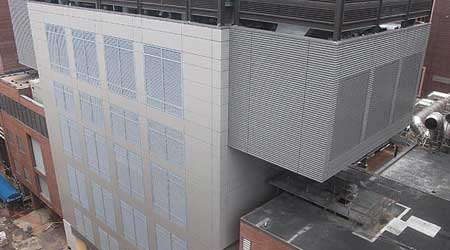2015 FMD Achievement Awards: Retrofits and Renovations
Recipients: Medical University of South Carolina, Charleston; Oral Roberts University/CityPlex, Tulsa, Okla.
By Dave Lubach, Associate Editor
Medical University of South Carolina, Charleston

The Achievement: Retrofitted the HVAC system, reducing maintenance costs by $75,000 annually and lowering fuel use by 10 percent
 The Benefits: Recognizing a potential risk of total system failure — including normal and emergency power, steam, chilled water, medical gas, and waste disposal infrastructure resulting from tropical storm flooding prevalent in Charleston — the Medical University of South Carolina undertook a major utility infrastructure relocation and upgrade to mitigate this risk and improve energy-efficiency in the process. All of the university’s utility equipment was moved from below flood level to above levels to avert potentially catastrophic damage.
The Benefits: Recognizing a potential risk of total system failure — including normal and emergency power, steam, chilled water, medical gas, and waste disposal infrastructure resulting from tropical storm flooding prevalent in Charleston — the Medical University of South Carolina undertook a major utility infrastructure relocation and upgrade to mitigate this risk and improve energy-efficiency in the process. All of the university’s utility equipment was moved from below flood level to above levels to avert potentially catastrophic damage.
The new equipment included three new high-efficiency fire-tube boilers, a new domestic-water multiplex variable-speed pumping package, three new medical-air and medical-vacuum systems, and four new cooling towers with variable-frequency tower fan control. The project also consolidated three emergency power plant locations into one system. All the systems are integrated in the hospital’s building automation and energy management controls.
The project has significantly reduced maintenance and repair costs, improved energy efficiency, and increased reliability and capacity.
— David Dement, Director of Facilities
Oral Roberts University/CityPlex, Tulsa, Okla.

The Achievement: Upgraded HVAC system, lowering overall electricity use by 32 million kilowatts, despite the addition of a 31,000-square-foot student center
 The Benefits: Being able to shift operating expenses from the utility budget into the repairs and maintenance budget was a huge benefit. As the utility expenses were reduced, more funds were available to spend in repairs and maintenance, which became a snowball effect.
The Benefits: Being able to shift operating expenses from the utility budget into the repairs and maintenance budget was a huge benefit. As the utility expenses were reduced, more funds were available to spend in repairs and maintenance, which became a snowball effect.
Capital funds also become available as the downward trend continued. As a result, the changes not only saved energy. They improved tenant comfort, reduced maintenance labor for temperature adjustments, and allowed for more time with repair and maintenance. The overall maintenance has improved because equipment runs fewer hours, and the variable-frequency drives use a soft start, saving belts, bearings, and motors. The useful life of the equipment has been extended due to the extra maintenance time and the changes in the operation of the equipment.
— David King, Director of Energy Management
Related Topics:









 The Benefits: Recognizing a potential risk of total system failure — including normal and emergency power, steam, chilled water, medical gas, and waste disposal infrastructure resulting from tropical storm flooding prevalent in Charleston —
The Benefits: Recognizing a potential risk of total system failure — including normal and emergency power, steam, chilled water, medical gas, and waste disposal infrastructure resulting from tropical storm flooding prevalent in Charleston — 
 The Benefits:
The Benefits: 


